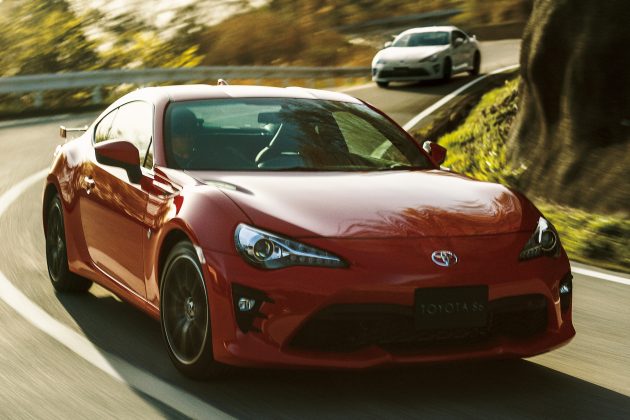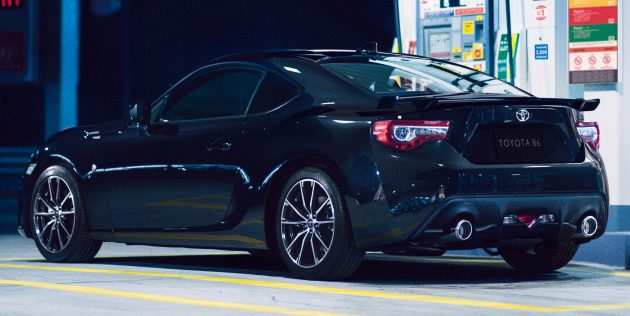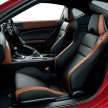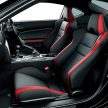Nearly four months after the facelifted Toyota 86 made its debut at the New York International Auto Show (NYIAS), the revamped front-engined, rear-wheel drive sports coupé is finally going on sale in its home market of Japan. Toyota claims that the refresh incorporates knowledge gained from racing, particularly the 24 Hours of Nürburgring.
“We overhauled everything – primarily as a result of technological feedback from the 86’s participation in the 24 Hours of Nürburgring – and repeatedly tested the vehicle on roads all over the world as we manufactured every single part,” said chief engineer Tetsuya Tada. “The new 86 has been perfected to such an extent that, from the moment the steering wheel is gripped and the vehicle accelerates away, every driver will be able to recognize its evolution.”
This evolution starts with the exterior. As we’ve previously seen, the 86 gets a heavily revised front bumper with a lower nose, a wider grille opening and fins on the new fog light bezels. Full-LED headlights are standard-fit on all models – integrating LED indicators that were previously found on the bumper – while LED fog lights can be found on the GT and GT Limited models.
Along the sides, the fake fender vents have been redesigned, with the new 86 badge (losing the boxer piston design) moved lower down the fender; new 17-inch machine-finish alloy wheels have also been fitted on the GT and GT Limited models. Finishing off the changes are new LED tail lights, as well as a revised rear bumper with a wider diffuser insert that gives the car a stronger stance. A new wing-type rear spoiler, as seen on the also-revised Subaru BRZ twin, is standard on the GT Limited.
Inside, the 86 benefits from a new three-spoke steering wheel, with GT and GT Limited models gaining multifunction controls on the spokes. Also only available on the top two trim levels is a revised instrument cluster with a 4.2-inch TFT LCD colour multi-info display that shows information such as G force, power/torque curves, and a stopwatch. On these models, the rev counter has also been reconfigured so that the very top of the meter says 7,000 rpm – where the engine produces maximum power.
Elsewhere, the GT and GT Limited models gain carbon print trim on the power window switch surrounds and climate control panel, while the GT Limited gains Grand Luxe suede-like trim on the dashboard and door cards, and Alcantara upholstery for the seats.
Under the bonnet, the 2.0 litre FA20 D-4S direct-injected flat-four engine has been breathed on with revisions to the intake and exhaust system, netting maximum outputs of 207 PS at 7,000 rpm and 212 Nm of torque between 6,400 and 6,800 rpm – increases of 7 PS and 7 Nm. That’s only with the six-speed manual transmission; models fitted with the six-speed automatic soldier on with the same figures as before.
To increase rigidity, the number of spot welding points on the rear pillars has been increased – in concert with the revised springs and dampers, this provides increased steering response and ride comfort. These attributes can be improved still further by opting for the optional Sachs dampers.
Prices start at 2,623,320 yen (RM102,900) for the base G manual and 2,647,080 yen (RM103,800) for the automatic model. Moving up, the GT costs 2,981,880 yen (RM116,900) for the manual and 3,048,840 yen (RM119,600) for the auto, while the range-topping GT Limited retails at 3,183,840 yen (RM124,900) for the manual and 3,250,800 yen (RM127,500) for the auto.
Looking to sell your car? Sell it with Carro.





































































AI-generated Summary ✨
Comments on the Toyota 86 facelift highlight its high price in Malaysia, attributed to import taxes, high profit margins, and local distributor UMW Toyota's pricing strategies. Some commenters express disappointment that the car is more affordable in countries like Australia and Thailand, criticizing the Malaysian government’s taxation and supporting local brands like Proton. Others mock the pricing as excessive and compare it unfavorably to more affordable options, emphasizing support for local industry. A few comments briefly mention unrelated topics like politics, race, and other car brands, but overall, the sentiment is that the 86’s price is inflated due to government policies and distributor greed, overshadowing its appeal as an affordable sports car.